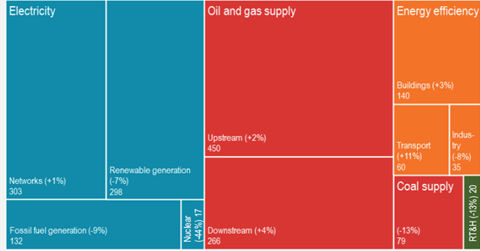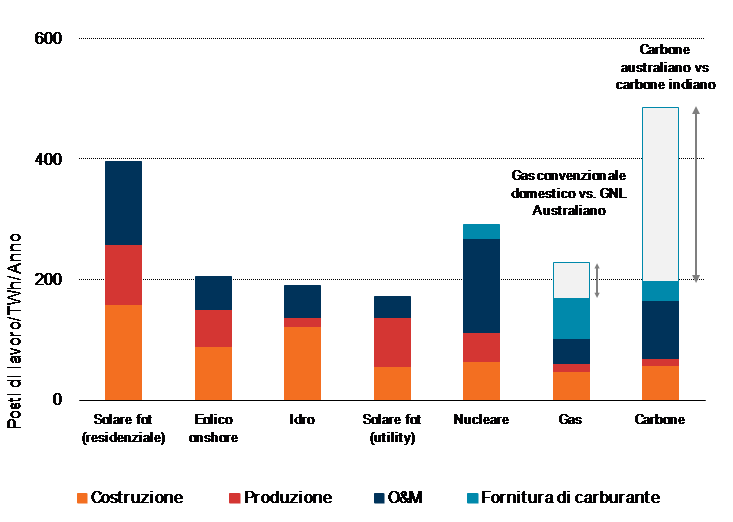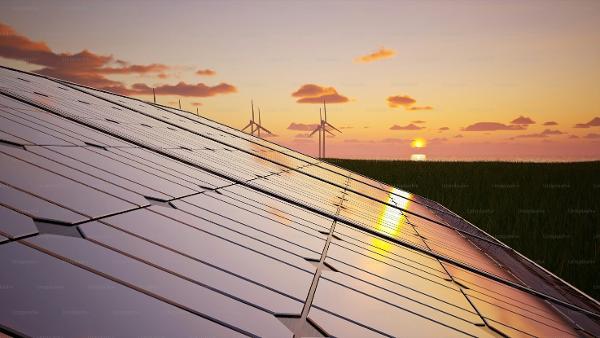Energy infrastructure is an indispensable foundation for all countries’ economies. Investment in the energy system can influence its development path. Thus, this investment has an important impact on employment, but the links are often complex, involving long value chains and requiring trade-offs. These days the topic is often raised in relation to environmental and climate-related policies; raising concerns about potential threats to fossil fuel jobs and hopes for job creation in the renewables sector. While the complexity of the supply chain makes it difficult to quantify net impacts and draw universal conclusions, our analysis indicates some interesting insights into direct and indirect job creation by energy investment.
The IEA’s latest World Energy Investment report shows that in 2017 global energy investment fell for the third consecutive year, by 2% to USD 1.8 trillion due to less power generation investment, lower costs and slow recovery in the oil and gas sector.
Global energy investment in 2017 and percent change from 2016

Source: IEA, World Energy Investment 2018
In electricity generation, the share of low-carbon technologies in investment (renewables and nuclear) remained at high level of over 70% (it was less than 60% at the beginning of the decade). Investment in coal-fired power decreased significantly due to fewer capacity additions in China and other emerging markets. Investment in gas-fired power increased but new gas turbine orders, an indicator of future investment, declined. Capacity additions of renewables were at record levels, while costs fell for some technologies such as solar PV and wind. Overall, however, the amount of low-carbon power generation added to the system by investments in recent years is in decline, largely due to lower contributions of hydropower and nuclear which run for more hours of the year.
In the fuel supply sector, investment in oil and gas supply reversed the trend of the last couple of years as companies are gradually increasing their activity. Yet, it remains at just two-thirds the level of 2014. Coal supply saw a significant drop in investment primarily driven by China.
We asked whether these recent investment trends – the shift towards spending on renewables and away from fossil fuel in electricity generation, the slow recovery in oil and gas supply investment and a huge drop in coal supply investment – are reflected in employment trends. Are more jobs being created in renewables and fewer in the fossil fuel-based generation and fuel supply sectors?
According to IEA analysis, the most labour-intensive types of power generation per unit of electricity generated are residential solar PV systems and coal-fired power plants in more labour-intensive countries. Rooftop solar PV, In particular, has high job-creation potential. Its installation is labour-intensive because the unit sizes are small unit size and the projects need to be customised. Renewable technologies generally require a higher share of employment in construction and manufacturing which require significant manpower for a relatively short time. Furthermore, due to its low capacity factors, more rooftop solar PV capacity must be installed upfront per unit of output. Sustaining employment levels necessitates continual deployment.
In thermal power, the operation and maintenance and fuel supply phases support employment for the entire operating life of a power plant. This varies significantly by country – coal mining in India can be 10 times more labour intensive than in Australia, where the industry is highly automated. In many cases, jobs in fuel supply are not created near the same region or country as the installed power generation capacity. This is also the case for equipment manufacturing of renewable and thermal power technologies alike.
Considering these factors, comparing employment impacts of investments in power generation technologies is not as straightforward as is often suggested by commentators. Regional differences within technologies can overwhelm differences between technologies.
Employment associated with 1TWh of new generation in 2016 by technology

Source: IEA, World Energy Investment 2017
Investment today will not have the same impact on jobs as investment tomorrow due to innovation. Innovation generally improves installation and operational efficiency over time, thereby lowering labour requirements, and can leap forward in response to competitive pressures.
For example, the oil and gas sector heavily cut back on capital expenditure and slashed headcount following the oil price collapse in 2014. Investment has not recovered as strongly as the oil price, in part because of companies’ continued efforts to keep costs under control and technological innovation, including digitalization, which has helped to dampen cost increases. The US shale industry has adopted a range of innovative techniques and equipment, such as geologic modelling with 3D seismic data, longer laterals with tighter spacing for fracking and walking rigs. These have increased labour productivity per barrel significantly. We expect the impacts of rising digitalization on employment to be felt across the energy system as data and analytics optimise power plant operation, robots clean solar panels and drones monitor wind turbines.
While investment and employment trends are closely related in the energy sector, it is clear that the quantity and quality of jobs associated with an investment can vary widely between, or even within, countries, depending on the industrial structure and energy mix of the local economy. History suggests that as technologies mature, their labour intensity declines, usually due to innovation. But this can increase competitiveness and the size of the market and open up opportunities for workers with new skill sets.
For a large, mature energy importer like Italy, investment in renewables and energy efficiency is likely to have a positive impact on employment and has synergies with its engineering industry. Yet to reap such employment benefits, the industry’s technical capabilities and forward-looking strategies will be crucial. In parallel, to maximise benefits and minimise adverse impacts on specific communities, policy makers at national and local levels can take measures to retain, redeploy and retrain the workforce.




















